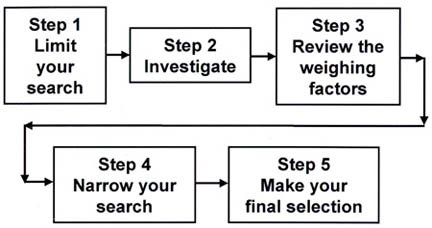|
Comparison StudiesComparison studies review different products and services to determine the highest quality best value product. Another phrase is comparison shopping.
We all compare products and services every day. For example, you do a comparison when you decide to go out to a nice dinner. There are usually several good restaurants to select from. Which one should you choose? Comparisons are usually on: price, location, quality of food, atmosphere and service. By comparing each of these you will decide which restaurant to visit. Comparing products can be used to decide on a wide array of choices. They can be used to decide on: what car to buy, where to live, what credit card to select and more. This section teaches how to set up and do your own comparison studies.
Consumer Reports®
Good examples of comparing products can be found in Consumer Reports Magazine. Consumer Reports® tests and reviews a wide assortment of products such as: cars, digital cameras, big screen televisions, appliances, printers, computer virus protection, exercise machines and more. Much of the information comes from consumers who rate the products. Consumer reports® assembles this information in an easy to read and understandable format. Their studies compare features of various products. Examples are: make and model, price, quality, reliability, and ease of use. Consumer reports® gives an overall score for these products. It provides Consumer Reports Best Buy Recommendations. If you are interested in seeing its examples of comparing products after reading this section and you haven’t used Consumer Reports® before, consider picking up a copy of the magazine on your next trip to a bookstore.
Creating Your own Comparison Studies There are two components composing comparing products. They are: 1. Subjective components
Objective components are definitive. These are measurable and scientific. For example, some of the questions answered in an objective comparison study are:
• Does this component exist (Yes or No)? • What is the cost of a product? This is sometimes a defined price. Other times it is a price range.
Comparing products usually involve both subjective and objective components. For example, consider purchasing a LCD television. An objective component would be the price range that the television cost should be within. A subjective element would be the quality/reliability that can be rated as poor, fair, good or excellent. Comparing products can be done for a wide assortment of consumer goods and services. A comparison focuses on primary elements of selecting a product.
The steps are straight forward. They are:
Steps for Doing a Comparison Study
Step 1: Limit your search
Select the factors that are most important to you. This is known as establishing selection criteria. Most comparisons of products and services start with three important factors. They usually are:
• Price
Today there are many options available in a wide array of products and/or services. It is important to have general idea what you are looking for before starting to compare products. General reading about the product or service can help you limit your search.
Step 2: Investigate Use the internet as well as bookstores, libraries, magazines and experts for your investigation.
Step 3: Review the weighing factors A weighing factor is the relative importance (ranking) of each factor used in a comparison study. Price, quality, reliability and usefulness are usually the most important factors when making a decision on most products or services. Other factors will also need to be considered. Many items will eliminate themselves because of high price, low quality or lack of usefulness.
Step 4: Narrow your search
After completing your investigation and deciding on the relative importance of the various factors, narrow the search of products or service to a handful of possibilities (options) that meet your needs. The pareto principle can help you narrow the search. Look for the 20% of products that have the highest quality/reliability, highest usefulness within the price range you have decided on.
Step 5: Make your final selection
Set up a comparison study chart for the handful of narrowed down to products. Do a comparison and make a selection.
Click here to see an example of a Comparison Study Do you want to unlock the power of critical thinking and create an amazing future? If so, click the link and get your copy of Mastering Critical Thinking today! Return from Comparison Studies to Problem Solving Techniques |


